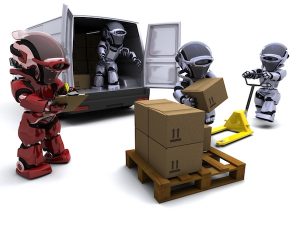The days of heading out to pick up food from a restaurant are coming to an end, at least in Washington, DC. A fleet of roughly 20 autonomous, knee-high neighborhood delivery robots recently appeared on the sidewalks of the nation’s capital. Their mission is to revolutionize hyper-local delivery in the big cities by bringing takeout food from restaurants to the hungry customers at home, while keeping the cost of delivery to around a dollar.
Each one of the neighborhood delivery robots weighs about 35 pounds, and is equal to a medium-sized cooler on six wheels, and averages about four miles per hour. They are equipped with lights, and a tall, bright-orange flag to make it more visible to pedestrians.
With a smartphone app, the shiny black lid is unlocked so the hollow, insulated holding area can be accessed, and then it automatically locks back into place.
The bot moves like a giant remote-control car, except there’s no remote. It drives entirely on its own, navigating the sidewalk using artificial intelligence technology that draws input from nine cameras all around the rim, GPS, and sensors that can help identify the speed of pedestrians in the immediate area.
With nine on-board cameras, it is highly important that each one be equipped with the highest-grade precision lens. At Universe Optics, we pride ourselves in the fact that our engineering department, along with the team at our manufacturing facility, work closely with your designs to ensure the lenses created for your neighborhood delivery robots are exactly what you expect.
Along the same lines, driverless vehicles offer a smart solution that also meets the challenges of urban mobility. With the seamless integration of a driverless vehicle and a delivery robot, comes a more efficient and effective way to distribute goods to the consumer.
This type of driverless vehicle is often considered a solution for urban ‘first or last mile’ mobility. Often referred to as a robo-taxi or pod – this type of vehicle will be part of the seamless mobility ‘value chain’. The purpose of these vehicles will be extended into the goods delivery market to further utilize the available transport capacity and reduce idle times of other types of delivery systems.
Market estimations are showing that the need to transport goods will begin to outpace the strongly growing need for people to transport in some densely populated areas.
Goods and parcel delivery to residential areas is a growing and dynamic market, driven by e-commerce sales that are increasing every year. With the growth of this segment, delivery cost per hour is gaining importance. This positions last mile and delivery services as a differentiator. Automated goods delivery is forecasted to provide an answer for up to 80 percent of all business-to-consumer deliveries, according to multiple research sources.
Whether you are designing neighborhood delivery robots, or driverless vehicles for delivery systems, UKA is here to design the lens you require.